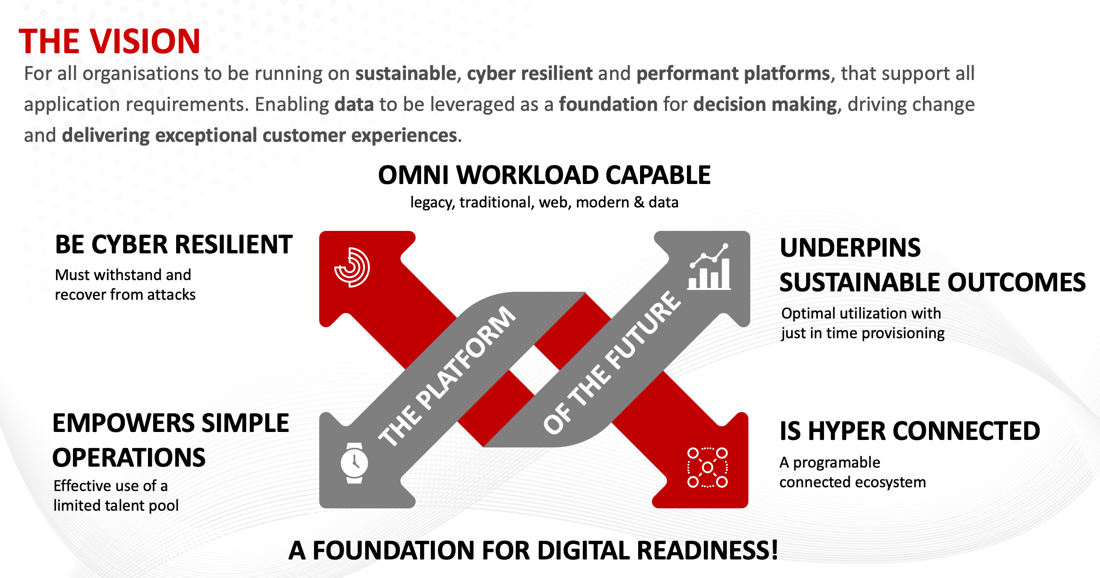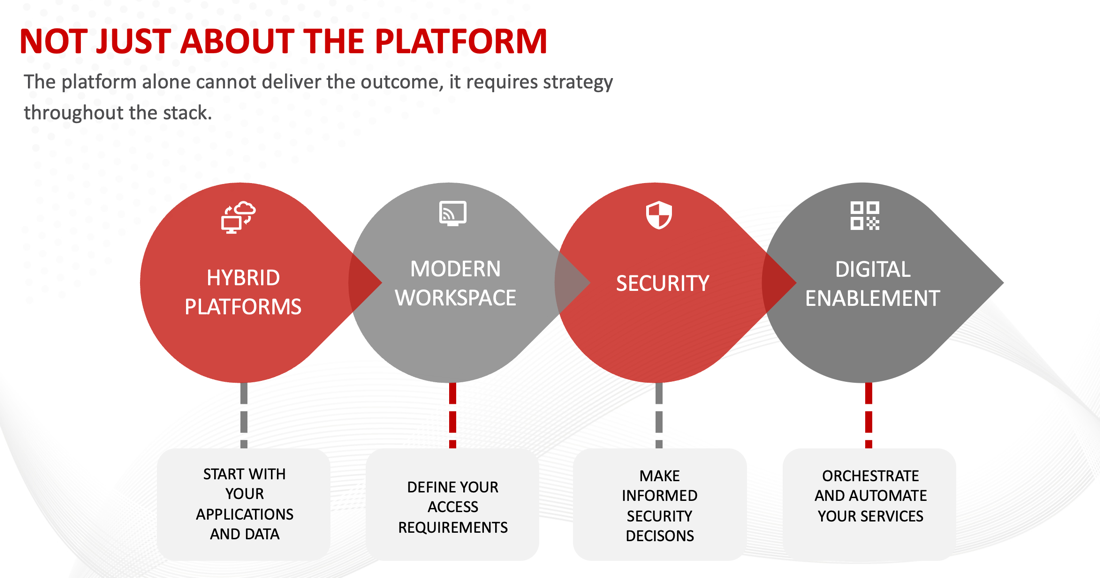So, how do we approach cloud adoption in the right way? First, we need to drop all the preconceptions about what is right and wrong. We must remove bias, preconceptions, accepted norms and whatever trends are currently grabbing the headlines.
Focus on the following four elements to guide you to the right outcome.
Business Strategy > Data Strategy > Application Strategy > Technical Strategy
Then wrap an adoption framework and governance structure around everything to ensure continued alignment to the agreed outcomes. This is key to stopping the drift, whilst ensuring the strategies remain agile enough to meet business needs.
Our Platform of the Future vision is a good place to start when thinking about defining those high-level strategic needs from your cloud operating model. Defining your own vision can provide a guiding light for everyone to focus on and ensure a consistent approach. These are the five core principles of the Platform of the Future. They define our vision of the capabilities and functions needed to provide the foundation of a digital business.
- Omni Workload Capable- Be Cyber Resilient
- Underpin Sustainable Outcomes
- Empowers Simple Operations
- Is Hyper Connected

Understand Business Strategy
How will you differentiate within your market? What is the vision for the organisation? How well are these things understood and aligned between business leaders and those defining technical strategy? This should be a symbiotic relationship with business and tech feeding in and learning from each other in a continual cycle.
Define Data Strategy
Data will likely be the foundation for the future business strategy. Understanding the target state of the data platform, considering relevance, accessibility, governance, and performance will be critical.
I call this its own workstream, and it can require different people, skills, and technologies to activate access to data for all that will need it.
Whilst underpinned by traditional technical components like networking, storage and data protection, the real value will come from modern Data Fabric technologies and lakehouse concepts. Both areas will need tight alignment of traditional IT services and the data architects in your organisation. Without this alignment, there is a risk of security gaps forming and data not being available in the correct format and locations to support the organisation.
Plot Application Roadmap
Create a lifecycle map for every workload in your estate, what type of application it is, what resources it consumes, what interdependencies it projects (other apps, access methods, security implications, etc.), and when its license costs refresh. Put all this data into a system (or spreadsheet as a last resort) and use this data to find the patterns and understand the true TCO of each workload.
Leveraging the standard 6 Rs process is a good foundation here, but you must consider the wider impact of modernisation. There could be savings and costs in the technologies that surround each workload, and these should be captured and understood. For example, an older app might be expensive to move to SaaS, but the associated savings in your workspace and security portfolios could offset this.
The act of putting all this information down ‘on paper' cannot be underestimated; many patterns will come to light that could unlock new paths forward and help you avoid costly mistakes.
Technical Strategy
Once the business, data and application strategies are known, the technical elements can be defined to underpin outcomes.
Agree Placement Rules
As part of defining your cloud strategy, it is important to define the execution environments that will be needed to support your digital aspirations. We talked about these as part of the Right Workload | Right Platform section in Part 2 of this series.
Once you understand which environments will support your digital future, it's important to define the rules and gates that will ensure appropriate adoption. This workflow should be followed for each new workload you onboard, and if defined correctly, will ensure the long-term feasibility of each environment. A simple starting point could be the eight factors listed below:
- Performance Requirements- Application Ecosystem
- Security & Compliance
- Data Sovereignty
- Network Latency
- Cost
- Environmental Impact
- Scaling needs
A simple scoring matrix combined with some compliance-based yes/no gates would allow for a simple decision process. Combine this with a guiding principle like SaaS > PaaS/Modern > VM-based/traditional, and you have a basic framework for ensuring the adoption of the correct execution environment.
Modernise Foundation Services
One of the core starting points for a successful cloud adoption program is to look at the foundation services that will underpin the business outcomes. Network Services will be key to connecting environments and making data accessible to applications and users. Without an adaptable foundational fabric, any transformation journey will falter.
Driving a change in the way services are delivered and orchestrated is important. Things like automation, configuration management, self-service, service catalogues and workflows will be key to the cloud operating model. These are elements that should be adopted as part of core practices across the entire estate, regardless of public or private cloud outcomes. This orchestration layer will need to be matured over time to become a solid foundation for delivering services.
Building an Observability practice to allow effective management of what is likely to become a complex and dynamic mesh of platforms, data and applications will also be key. Stepping up from traditional monitoring to comprehensive observability will allow deeper insight into system behaviours, enabling proactive problem-solving and improved incident response. Without this insight, it will become very difficult to maintain service levels and deliver the customer experience that is desired.
Data Protection and Cyber Defence will become a key foundation for any cloud adoption program. With the spread of systems and data to new dynamic environments, ensuring people are skilled and processes are aligned will be critical to avoiding that embarrassing cyber incident.
Define CCoE - Drive the cultural change
Following on from the foundational services at a technical level, you should look at establishing a Cloud Centre of Excellence (CCoE) to help drive standards and cultural change. For many in your organisation, cloud ways of working will be new, and everyone needs to be taken on the journey. Here are eight elements that your CCoE should be focusing on:
- Leadership and Governance- Standards and Best Practices
- Cloud Architecture and Design
- Security and Compliance
- Cost Management and Optimisation
- Training and Enablement
- Operations and Automation
- Innovation and Agile Development
A well-structured CCoE should act as the cornerstone for continued cloud adoption and management, ensuring organisations can leverage cloud technologies effectively to drive innovation, agility and customer satisfaction.
Independent Assessment
The final point I want to circle back to from the first part of this series is the part that assessment services play in overall cloud strategy. Completing assessments that are based on a single vendor outcome is, in most cases, going to lead to a single vendor result. Whilst these services can be obtained free of charge, the longer-term cost impact of using this biased data could be significant. Leveraging tooling and services that don’t have a pre-defined outcome and considering all possible execution environments for workloads.
The level of planning and discovery conducted before and during the transformation program will directly impact the overall success. There are too many projects we are asked to rescue that have not been started without the solid foundations discussed in this series.
Define and Document Technical Strategy
A key step in this process is the documentation and definition of standards. This new operating model cannot reside in a few key people's heads. It needs to be organisation-wide and embedded into day-to-day life. Strong documentation and practices of the continuous evolution of this will be key to ensuring the ship stays on course and bad habits are kept at bay. Define the functional and non-functional requirements, then use these to validate each technical decision made. Three steps we talk with customers about are:
- Define Focus Domains to align strategy against – Data, Cyber, Workspace, Cloud etc.
- Agree on the principles that you will operate within, things like SaaS-first or zero trust
- Finally, define the trigger points that will drive a review, such as end-of-life, regulatory change, or business strategy shift
This can become the North Star of sorts; guiding the transformation to deliver what the business needs to succeed rather than what a vendor, partner or industry trend seems to demand.
Summary
Cloud technology offers many potential futures for every organisation, with options to modernise across all areas. If done correctly, it should drive innovation and allow the business to differentiate, move to new revenue streams, and unlock its future potential.
Public cloud services provide access to new innovation and scale to take advantage of opportunities. Private Cloud or Core services provide a place for traditional and legacy applications to run in a cost-effective manner. Edge services allow data to be exploited to enhance services or provide insights.
Finding the right adoption model for your organisation is key. Don’t follow the hype, do your research, leverage independent assessment data and shortcut to the future state that will unlock that potential!
One final thought I wanted to leave you all with: it's not just a platform conversation. Please consider your strategy throughout the stack. We look at this in four stages: Platforms for data and applications, workspace to provide access to them, and security services to protect all. You cannot do this in isolation as decisions in one area will impact the next. Finally, digital enablement comes along and orchestrates and automates all those systems to deliver a delightful user experience.


